Top 10 Digital Customer Service Platforms for 2025
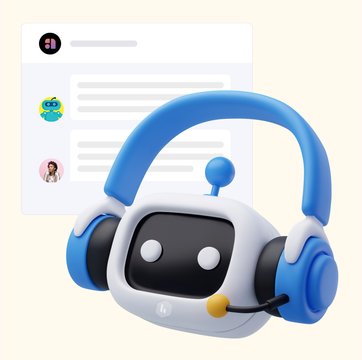
Table of contents
The methods which customers prefer for reaching out to businesses for support have changed over the years. Traditional methods like physical interactions or phone calls, while they still exist, have dipped in popularity. Most people now prefer digital channels to get their queries resolved which is where digital customer service platforms come in.
Most of it has to do with the convenience that these channels offer. You can reach out for support anytime, anywhere without needing to make a phone call. It’s also significantly quicker because channels like live chat or automated chatbots can handle simple queries instantly.
In fact, I can say, anecdotally at least, most people today seem to prefer text-based-communication rather than talking on a call. Personally as well I’d much rather type out my issue and get it resolved in a chat. Only as a last resort would I move to a phone call if I was dissatisfied with the service.
So investing in a capable digital customer service software and being present on channels your customers favour is very important for businesses.
In this guide, I’ll talk about the 10 best digital customer service platforms in 2025 you can choose from for your business. I’ll discuss each platform’s capabilities, pros, cons, and pricing so you can figure out which one works best for you.
Table of Contents
- What is a digital customer service platform?
- 10 Best Digital Customer Service Software in 2025
- How to choose the right digital customer service software?
- A digital customer service platform helps you keep up with customer expectations
What is a digital customer service platform?
A digital customer service platform is a software designed to help businesses manage and respond to customer queries through various digital channels like email, social media, and live chat. It essentially helps businesses meet their customers where they are.
There are quite a few benefits to opting for such a tool –
- 24/7 Availability: AI chatbots make it so that customers can reach out for support at any time -even outside regular business hours – and get an instant response to their query. This is a very attractive option for customers.
- Multi-channel Support: Digital customer service software allows businesses to interact with customers through various channels like chat, email, social media etc. So your customers have the option to get in touch with you with whichever channel they prefer.
- Centralized Management: All customer interactions are managed from one central platform, making it easier to track and resolve issues. Your agents know what they need to work on and your supervisors can keep an eye on everything.
- Data and Analytics: Most well-designed customer service software offers insights into customer interactions and agent performance. This way you learn which areas your customers are facing trouble with and need to work on. You can also monitor individual agent performance to identify and incentivize team members that are performing well and support those who need some assistance.
- Cost-effective: If you pick the right tool for your business you can effectively save a lot of dollars in the long run. Digital customer service platforms automate a lot of functions like assigning queries to your agents. They also streamline workflows and increase the overall productivity of the support team. This means that fewer agents can manage more inquiries, reducing the cost per interaction.
10 Best Digital Customer Service Software in 2025
Now let’s look at the 10 best digital customer service platforms in the market right now and break down their features, pros, cons, and how much they’ll cost you. This list is all you’ll need to make an informed decision if you’re interested in investing in such a tool or are looking to switch out your existing software.
1. Hiver
Hiver seamlessly transforms your Gmail or Outlook inbox into a centralized platform, from where your support staff can respond to customer queries coming in from multiple channels like email, live chat, phone, and WhatsApp.
Since it sits on top of your inbox, your agents don’t need to learn a new platform from scratch. It’s extremely intuitive which also means there’s minimal learning curve.
Despite its simplicity and ease-of-use, Hiver comes with all the features you could want in a customer service software. Let’s look at some of them below.

Key features
- Unified Inbox: Hiver consolidates customer interactions from multiple channels, such as email, voice, Whatsapp, and live chat, into a single shared inbox, making it easier to track and manage customer queries.
- Collaboration: Teams can attach notes to customer queries, ensuring that everyone working on a specific issue has complete context. Avoid overlapping replies with real-time collision alerts.
- Analytics and Reports: Hiver provides detailed insights into metrics like response time, resolution time, and customer satisfaction. This helps teams understand their performance and areas of improvement.
- Automations: Hiver allows for setting up automation rules, ensuring that repetitive tasks like categorizing certain types of queries are handled automatically.
- AI-powered: Hiver also comes with a host of innovative AI features such as email summarizer, intelligent email template suggestions, and auto-closing of non-actionable emails.
- Knowledge Base: With Hiver you can build an internal knowledge base where you securely share and access sensitive documents within your organization or an external knowledge base to guide your customers to help themselves.
Pros
“With Hiver, I have much better visibility into where an issue is on the resolution path. And we’ve stopped missing emails. It is essentially like having an additional person on my team.” [Source]

“Support team is amazing. They will reply almost instantly and schedule meetings for more complicated matters within minutes. They are always ready to help. They also consider customer’s input when adding new features.” [Source: G2]
“The functionality of Hiver makes my life so much easier and I can see how they are responding, when they are responding and if they require clarification, they can tag me in a comment and I can help them out in a sinch! I also love the templates and the SLC – saves my team time and ensures we are responding to all emails in a timely fashion. Hiver has caught on in our organization and I will never do without it!” [Source: G2]
Cons
“I’d love to be able to create a ‘ticket’ within Hiver on behalf of a customer. Currently tickets can only be created based on an email interaction between a customer and our company.” [Source: Capterra]
Pricing
Hiver has three pricing plans to choose from –
- Lite plan: $19 per user per month.
- Pro plan: $49 per user per month.
- Elite plan: $79 per user per month.
Free trial: 7 days
2. Help Scout
Help Scout is a cloud-based customer service software that helps businesses offer personalized support to their customers at scale. I’ve mentioned Help Scout very early on in the list because the tool is reputed to be very user-friendly.
It has a simple interface that makes it easy for support teams to manage customer interactions across various channels, including email and chat. Let’s look at some of the key features this software offers.
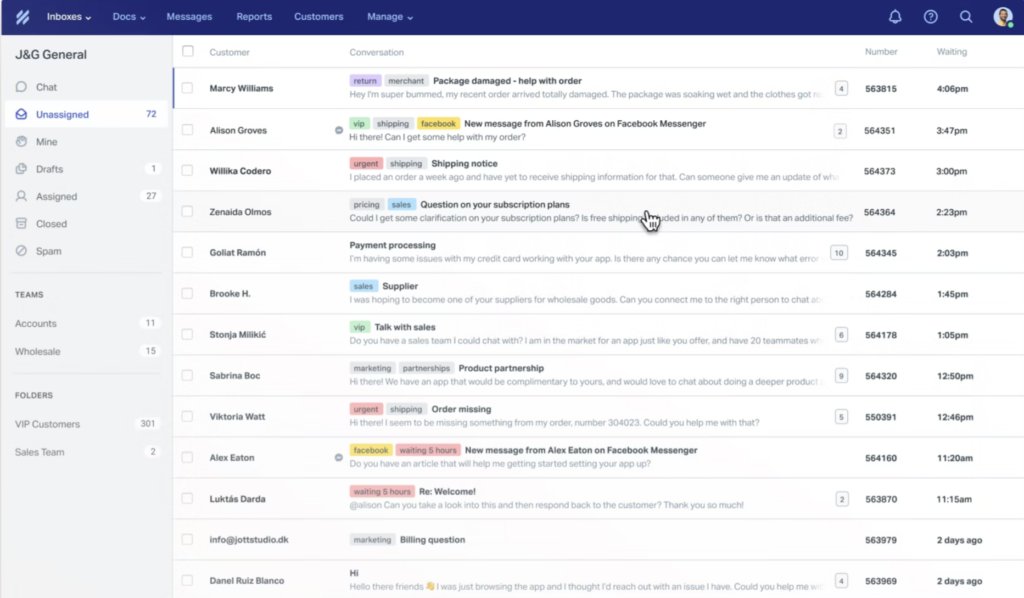
Key features
- Shared Inbox: The shared inbox feature allows teams to manage customer emails collaboratively. It ensures that no inquiries slip through the cracks and that multiple team members can work together on complex issues.
- Live Chat: Help Scout offers an integrated live chat feature called Beacon, which lets businesses provide real-time support to their customers. Beacon can be customized to match your brand guidelines and offer proactive support based on the user’s behavior on your website.
- Knowledge Base: Help Scout’s Docs feature allows businesses to create a knowledge base where customers can find answers to common questions on their own, reducing the number of support tickets.
- AI Summarizer: Help Scout also offers an AI summarizer feature that distills long emails and threads into simple, bullet points. This eliminates the need to read the entire thread to figure out what’s going on and what next steps should be.
Pros
“Support is always quick to respond and helpful when we need guidance.” [Source: G2]
“The interface is clean, direct, and getting used to the layout is quick.” [Source: Capterra]
Cons
“So far, the only complaint we had was the “next” feature, once you reply to a ticket, the next open ticket assigned to you would pop up immediately, and if you’re not careful, you might respond the wrong thing to the customer!” [Source: Capterra]
“There is only one knowledge base template/design available, it will be great if we have different templates to choose from.” [Source: G2]
Pricing
Help Scout’s plans start from $22 per seat per month.
Free trial: 15 days.
3. Freshdesk
Freshdesk is a comprehensive digital customer support solution that provides a central, unified platform for businesses to manage customer interactions across multiple channels. It is popular among businesses of all sizes because of how flexible it is and its robust set of features like ticketing, self-service, automations and so on.
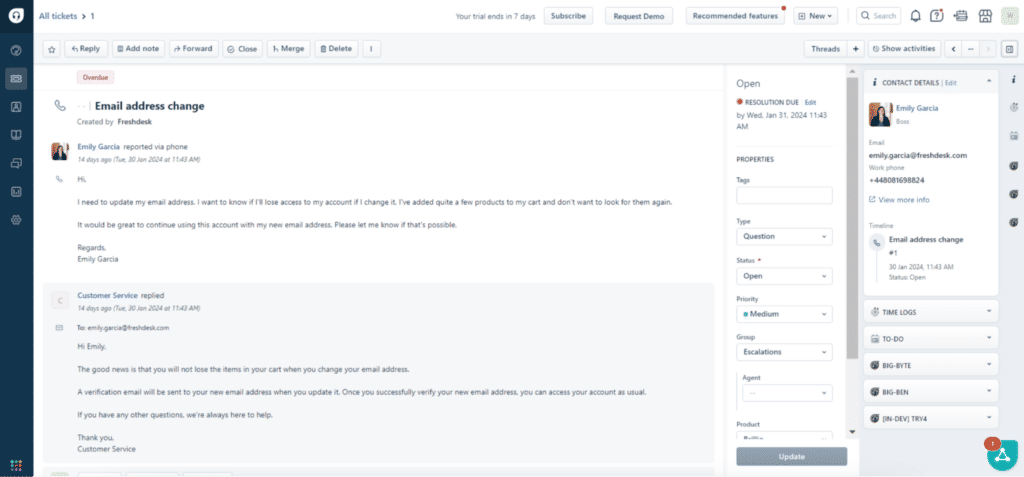
Key features
- Multi-Channel Support: Freshdesk enables businesses to manage customer interactions across various channels, including email, phone, live chat, social media, and more. This multi-channel capability ensures that all customer inquiries are captured and addressed from a single interface.
- Reporting and Analytics: Freshdesk provides detailed reporting and analytics that offer insights into support team performance, customer satisfaction, and operational efficiency.
- Customizability: Freshdesk is highly customizable, allowing businesses to tailor the platform to their specific needs. From custom ticket fields and workflows to personalized customer portals, Freshdesk can be adapted to fit different industries and service models.
- Freddy Self Service: Freshdesk’s AI bot, Freddy, can help you deploy an intelligent chatbot which can work on customer issues 24×7. This takes away a chunk of workload from your agents who can now focus on higher-value tasks or queries that need their inputs.
Pros
“Freshdesk is incredibly easy to use. More importantly, it is easy to train new agents and once they start using it they can become pros very easily.” [Source: G2]
“Easy access to daily, weekly, monthly reports and databases through this I am able to track the performances of the agents.” [Source: G2]
Cons
“The software does lag from time to time, it has been over 2 months since I’ve been using it and there have been a bunch of troubleshooting errors and unwanted crashes.” [Source: Capterra]
“The product is poor at detecting spam/promotional emails compared to other email tools, creating more work than necessary” [Source: Capterra]
Pricing
Freshdesk has a forever free plan (up to two agents) with very basic functionality. Their paid plans start from $15 per seat per month.
Free trial: 14 days.
4. Zendesk
Zendesk is one of the most popular customer service tools. It’s widely adopted because of the robustness of the features it offers. Like others in the list, Zendesk offers a unified interface where support agents can manage and respond to customer inquiries across multiple channels. The platform also seamlessly integrates with a wide range of business tools and CRM systems, which makes it very flexible.
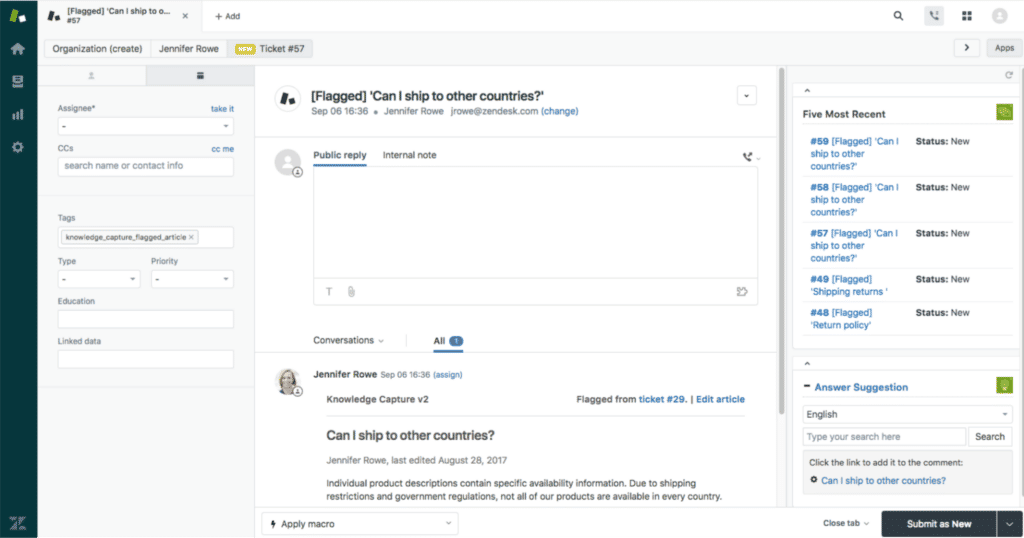
Key features:
- Live Chat and Messaging: Zendesk supports real-time communication through live chat, allowing agents to assist customers instantly. It also integrates with messaging apps for more flexible support options.
- Analytics and Reporting: Zendesk provides advanced analytics and reporting tools that give insights into customer support performance, helping businesses monitor key metrics like response times, customer satisfaction, and ticket resolution rates.
- Integrations: Zendesk integrates with a wide range of third-party applications, including CRM systems, eCommerce platforms, and collaboration tools, allowing businesses to streamline workflows and access customer data more effectively.
It’s worth noting that Zendesk’s robust features and extensive customization and integrations also make it a very complex tool to learn and work with. Your agents will need extensive training to get started with the tool and may find it difficult to navigate through the platform. Zendesk is also on the pricier end compared to other tools in the market.
Pros
“Zendesk Support is very customizable in every aspect, allowing for unique workflows for different teams across any organization.” [Source: G2]
“I like the compatibility of Zendesk and other programs/software. We have been able to integrate Slack, Intercom, and our own API. I think that it is more user-friendly for the agent than some other support tools.” [Source: G2]
Cons
“We’ve purchased their top tier plan and their services teams could care less. It takes days/weeks to get a reply and the answer is typically not helpful.” [Source: G2]
“Sometimes the abundance of features that we don’t use can overwhelm us while trying to find specific configurations.” [Source: G2]
Pricing
Zendesk’s basic plans start from $19 per seat per month but with very little functionality. Their more complete plans start from $55 per seat per month.
Free trial: 14 days
5. Front
Front is a collaborative digital customer service platform that centralizes emails, chats, and messages from various digital channels into a single, unified inbox. Front’s interface is designed to be intuitive and familiar, resembling a traditional email client, which reduces the learning curve and allows teams to get up and running quickly.
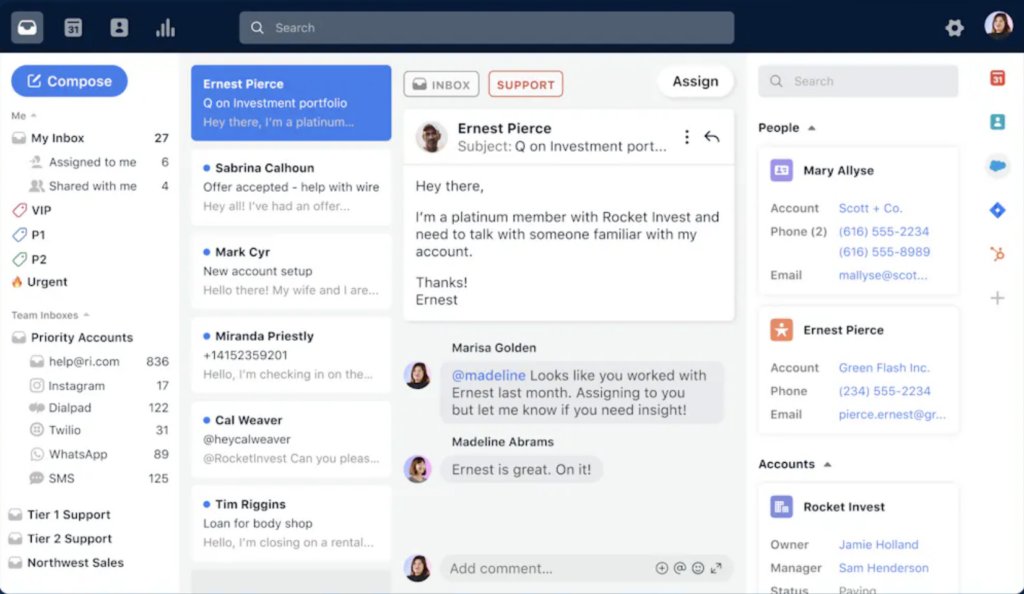
Key features
- Multi-Channel Communication: Front centralizes communication from various channels into a single, unified inbox. This enables teams to manage and respond to customer inquiries from different platforms without switching between tools.
- Collaboration: The platform allows team members to work in a collaborative way from their inboxes, sharing drafts, leaving comments, and assigning tasks to ensure that every customer query is handled promptly and accurately.
- Integrations with Third-Party Tools: Front integrates with a wide range of business applications, including CRM systems, project management tools, and chat apps.
Pros
“The internal team chat enhances communication and collaboration. The clarity of who is responding or seeing quickly that someone has responded so you do not waste time on emails that someone has already sent or is working on sending.” [Source: Capterra]
“Unlike Zendesk or similar products; emails you send from Front are actually sent from your email address, not a weird routing domain like yourcompany.zendesk.com.” [Source: Capterra]
Cons
“There are times that the correct email I am looking for shows in the middle of the search results. Since I have been using it for almost 2 years, I’m used to it but new users are sometimes confused and lost locating emails.” [Source: G2]
“The biggest issue we deal with is Front’s occasional latency. In an industry where fast is better than perfect, the last thing my team needs is Front to be lagging or down. We have a huge backlog of archived emails (Front also acts as customer documentation platform for us) so searching information can be super tedious if the platform doesn’t load or crashes.” [Source: Capterra]
Pricing
Front’s paid plans start from $19 per seat per month.
Free trial: 14 days
6. Zoho Desk
Zoho Desk is another complete digital customer service tool built to help businesses deliver exceptional service to their customers. It’s a part of the larger Zoho ecosystem, which allows for seamless integration with other Zoho applications and makes it a versatile tool for businesses of all sizes.
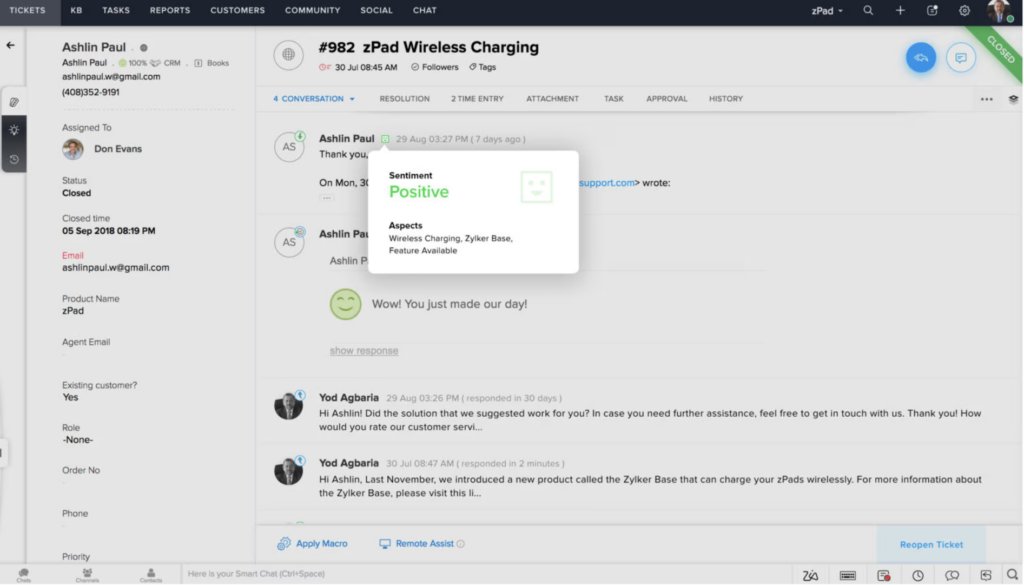
Key features
- Context-Aware Support: The platform provides detailed customer history and context for each interaction, enabling agents to deliver personalized and informed responses, which helps in resolving issues faster and improving customer satisfaction.
- AI-Powered Automation: Zoho Desk features Zia, an AI assistant that automates routine tasks, suggests solutions, and detects customer sentiment, allowing support teams to focus on more complex issues and operate more efficiently.
- Customizable Workflows: It offers extensive customization options, including the ability to create custom workflows, ticket layouts, and multi-department support setups, allowing businesses to tailor the platform to their unique needs.
Pros
“Zoho Desk’s ticketing system is highly intuitive, enabling our support agents to prioritize, track and resolve customer problems without difficulty.” [Source: G2]
“It’s a great mix of simple and easy to use and setup, but also has advanced features for when you need more. Plus it’s affordable.” [Source: G2]
Cons
“One thing that may be improved with Zoho Desk is the reporting capabilities. I need to export data to external programs to gain a full picture of my customer service performance because the present reporting options are inadequate.” [Source: Capterra]
“Learning curve for advanced features: While basic functions are easy to use, some advanced features might require additional training.” [Source: G2]
Pricing
Zoho Desk has a forever free plan with limited functionality. Its paid plans start from $7 per seat per month.
Free trial: 15 days
7. HappyFox
HappyFox is a digital help desk that helps businesses offer multi channel support. Businesses can leverage its many features like live chat, email ticketing, and knowledge base management to interact with their customers effectively.
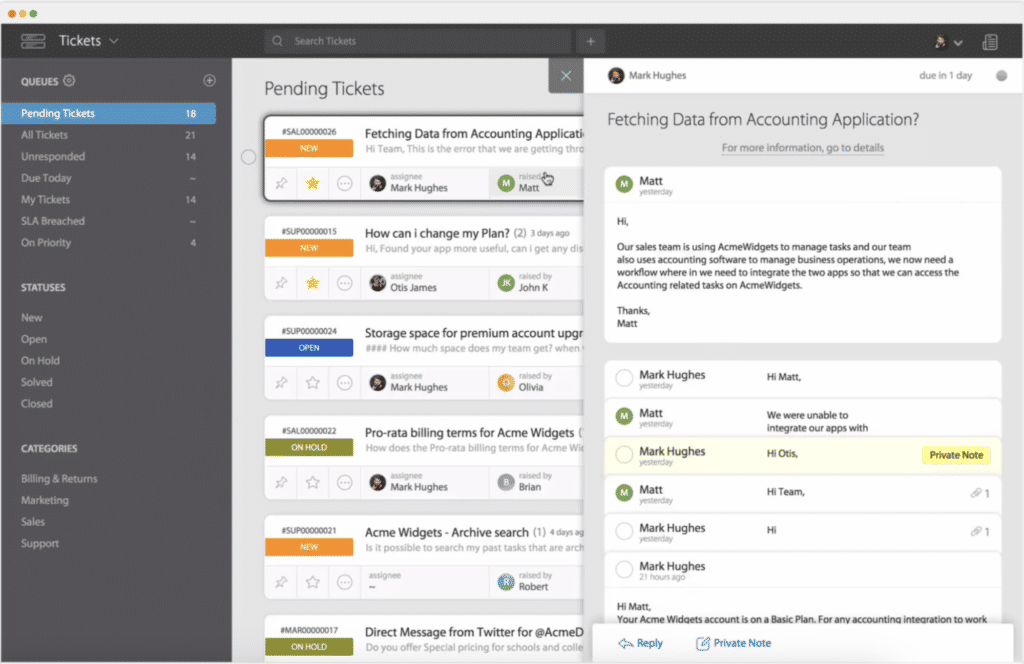
Key features
- Ticket Management: HappyFox helps organizations track, manage, and resolve customer support tickets from multiple channels, including email, social media, and chat.
- Knowledge Base: HappyFox allows companies to create a self-service knowledge base where customers can find answers to common questions, reducing the need for direct support.
- Reporting and Analytics: HappyFox offers robust reporting and analytics tools, providing insights into support team performance, customer satisfaction, and ticket resolution times.
- CSAT Surveys: Customer Satisfaction (CSAT) surveys can be sent automatically after a support interaction is completed. These surveys allow customers to rate their experience, providing valuable insights into how well the support team is performing.
Pros
“I love how easy and intuitive their software is to set up and configure, including customizing the knowledge base.” [Source: G2]
Cons
“Can be sluggish load-time wise. There are some minor UI inconveniences at times, such as having to type in the ticket ID when relating two tickets vs being able to search by name and select that way.” [Source: Capterra]
Pricing
HappyFox pricing starts from $9 per agent per month (up to 5 agents) with limited functionality.
Free trial: 14 days
8. Gorgias
Gorgias is a help desk and digital customer support software specifically designed for eCommerce businesses. It enables online stores to manage and streamline their customer service operations by centralizing customer interactions from various channels into a single platform.

Key features
- eCommerce Integration: Gorgias integrates seamlessly with popular eCommerce platforms like Shopify, Magento, and BigCommerce. This integration allows support agents to view customer data, order histories, and other relevant information directly within the helpdesk, making it easier to provide personalized support.
- Macros and Templates: Gorgias allows teams to create and use pre-written responses (macros) and templates to quickly address common customer inquiries, improving efficiency and consistency in communication.
- Self-Service Options: Gorgias supports the creation of a self-service help center where customers can find answers to common questions without needing to contact support.
Pros
“The best thing is the easy to use macro responses, my entire team loves to use them.” [Source: G2]
“Its user-friendly features. Everything you need is just a click away, everything is right up front. No need to spend hours searching, if you need to create a view for tickets, it is the easiest thing!” [Source: G2]
Cons
“If you want to integrate ebay or amazon, you need a third party add on which is itself limited. Prepare for additional costs.” [Source: Capterra]
“The platform could be great, but it is in a constant state of flux, and half the features don’t work for BigCommerce sites. The system is full of bugs and inconsistencies. The system is geared specifically to Shopify. If you are using BigCommerce, you will not be able to take advantage of many of the automated features.” [Source: Capterra]
Pricing
Gorgias’ plans start from $10 per month but with very limited functionality (includes 50 tickets per month + $0.40 for each ticket after that).
Free trial: 7 days
9. Kayako
Kayako facilitates customer interactions across various channels like email, live chat, and social media. It comes with over 600 integrations which lends it some added flexibility. Let’s look at some key features Kayako offers.
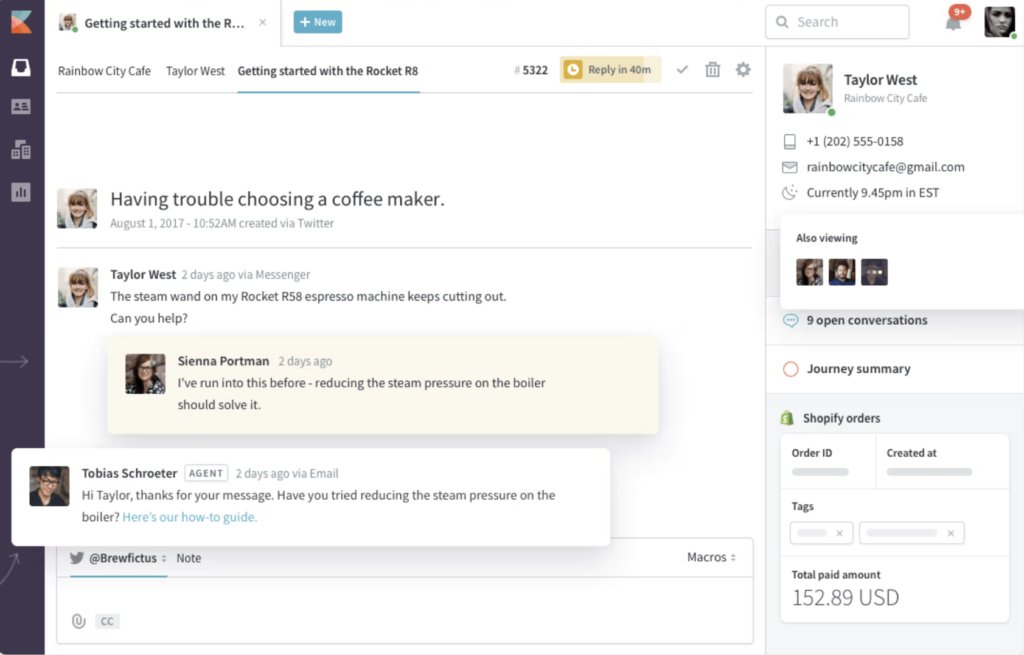
Key features
- Customer Journey Tracking: Kayako offers features that track the customer journey, giving support agents visibility into the customer’s past interactions, behavior, and preferences. This information helps agents deliver more personalized and context-aware support.
- Collaborative Support: Kayako supports team collaboration by allowing multiple agents to work together on resolving a ticket. Agents can leave internal notes, tag colleagues, and share information to ensure that complex issues are addressed effectively.
- Reporting & Analytics: The platform provides robust reporting and analytics tools that allow businesses to monitor and measure the performance of their customer support operations. Metrics such as response times, resolution times, and customer satisfaction can be tracked to identify areas for improvement.
Pros
“The best feature of Kayako is that it allows you to organize your emails into folders based on departments, status and the nature of the email content.” [Source: Capterra]
“I found Kayako to be an easy-to-use product. The user interface is intuitive, making it straightforward to manage customer inquiries. Overall, a positive experience.” [Source: Capterra]
Cons
“The after-sale support is terrible. Once you sign up, that’s it, they will not answer any of your questions. Promise big and deliver nothing. Not walk the talk.” [Source: G2]
“Reporting feature is terrible; should not have to know how to write a sequel query in order to run devoid reports.” [Source: Capterra]
Pricing
Kayako’s plans start from $15 per user per month.
Free trial: 14 days
10. Missive
Missive is a software application designed to enhance collaboration and communication. It combines team inboxes and chat into a unified platform (see below). Businesses can use Missive to simplify email management by using features such as assigning emails to specific members and using templates for frequently asked queries.
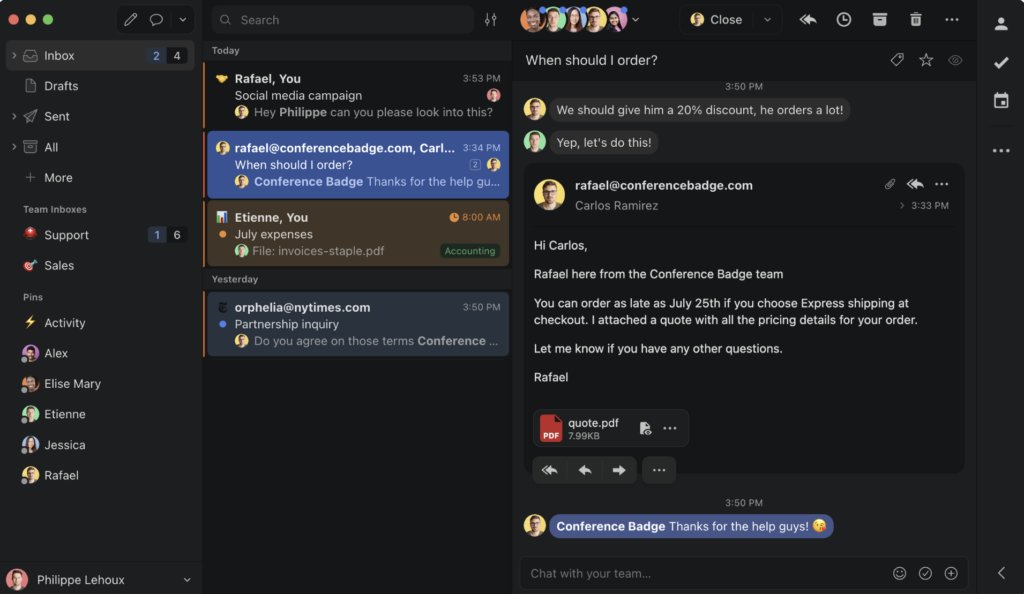
Key features
- Chat: Missive includes chat rooms where you can have discussions with your colleagues. You can chat one-on-one, with a group of employees, with your team, or with anyone in your organization.
- Team Email Drafting: With Missive, teams can work together on writing emails. You can ask a teammate for help and see their suggestions and changes as they make them. This is helpful in cases where you need to get a go-ahead from your manager before sending an email. Or when you want a colleague to double-check the information in your email before sending it.
- Templates & Canned Responses: Missive supports email templates and canned responses, allowing you to respond quickly to common queries and maintain consistency in your communication.
Pros
“One of the features I like most about Missive is being able to collaborate with others through chats on threads. This helps with getting tasks done promptly.” [Source: G2]
Cons
“I wish Missive had reporting. I’d also like the ability to default search just my inboxes rather than defaulting to searching all inboxes. Depending on the plan, there’s a limit to message history you can search or view.” [Source: G2]
Pricing
Missive starts from $14 per user per month.
Free trial: N/A
How to choose the right digital customer service software?
So we’ve narrowed it down to the 10 best tools for digital customer service in the market. But if you’re still confused about your choice, here’s a quick rundown of things you should consider before investing in the software to ensure you make the best possible choice for your company.
- Understand your specific needs: If you know exactly which features you need you’re on the right track. Let’s say your company has simple needs and just wants to manage customer emails. You value simplicity and ease-of-use, then you’ll likely be better off opting for a value-for-money, no-frills software. Whereas if you’re looking for a software with all the bells and whistles for a large team, then you can look for tools that can handle scale and are feature-rich like Zendesk.
- Integration capabilities: This one’s a no-brainer but be very clear about which integrations are a must for you and check to see if the softwares you’ve shortlisted are compatible. For example, Freshdesk integrates smoothly with HubSpot. With this integration, customer feedback collected through Freshdesk, such as customer satisfaction scores or common issues, can be automatically synced with HubSpot.
- Ease-of-use: Look for reviews and feedback around how easy a particular customer service platform is to use. This’ll save your agents the hassle of going through a steep learning curve and save you thousands of dollars in training costs. It’ll also make for easy onboarding of new agents in the future. For instance, users of Hiver praise it for how easy it is to get started with.
- Security and compliance: Very important, I cannot stress this enough. Ensure the software meets your industry’s security standards and compliance requirements to protect customer data. If you’re in healthcare for instance, you’d want a software that is HIPAA compliant.
- Pricing: And finally, costs. If you have a budget ear-marked for this then try to look for options closest to it. If you’re a little more flexible with your budget then go for the tool that gets you the most bang for your buck i.e. better, more features at a lower price point.
A digital customer service platform helps you keep up with customer expectations
Going back to what I said in the beginning, customers now favor text-based support channels and they value speed. So ensuring you’re available on multiple channels like email, live chat, chatbot, or social media is the need of the hour.
Investing in the right digital customer service platform that facilitates this, will play a significant role in how your agents perform and how your customers perceive your business. So choose wisely.


































